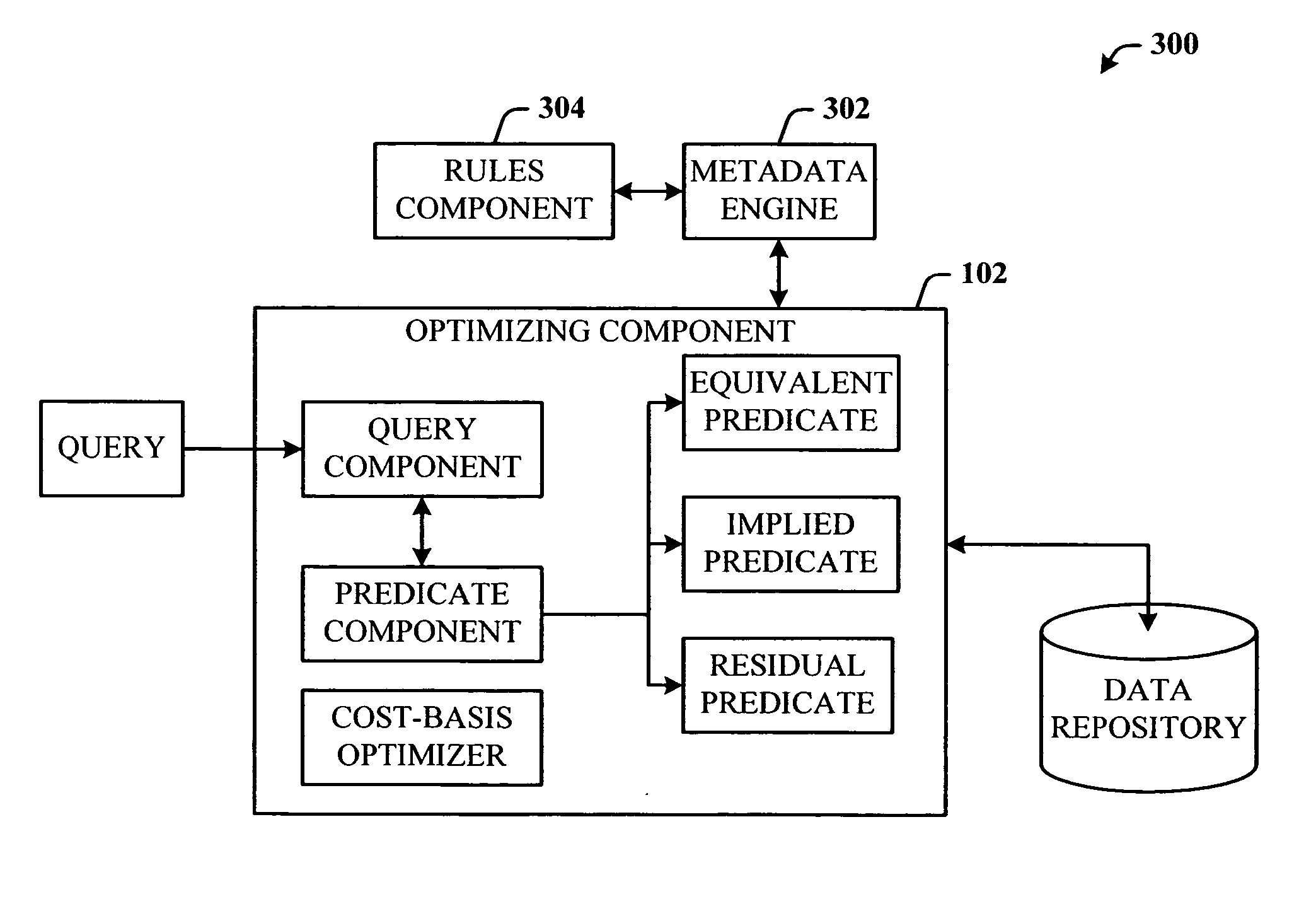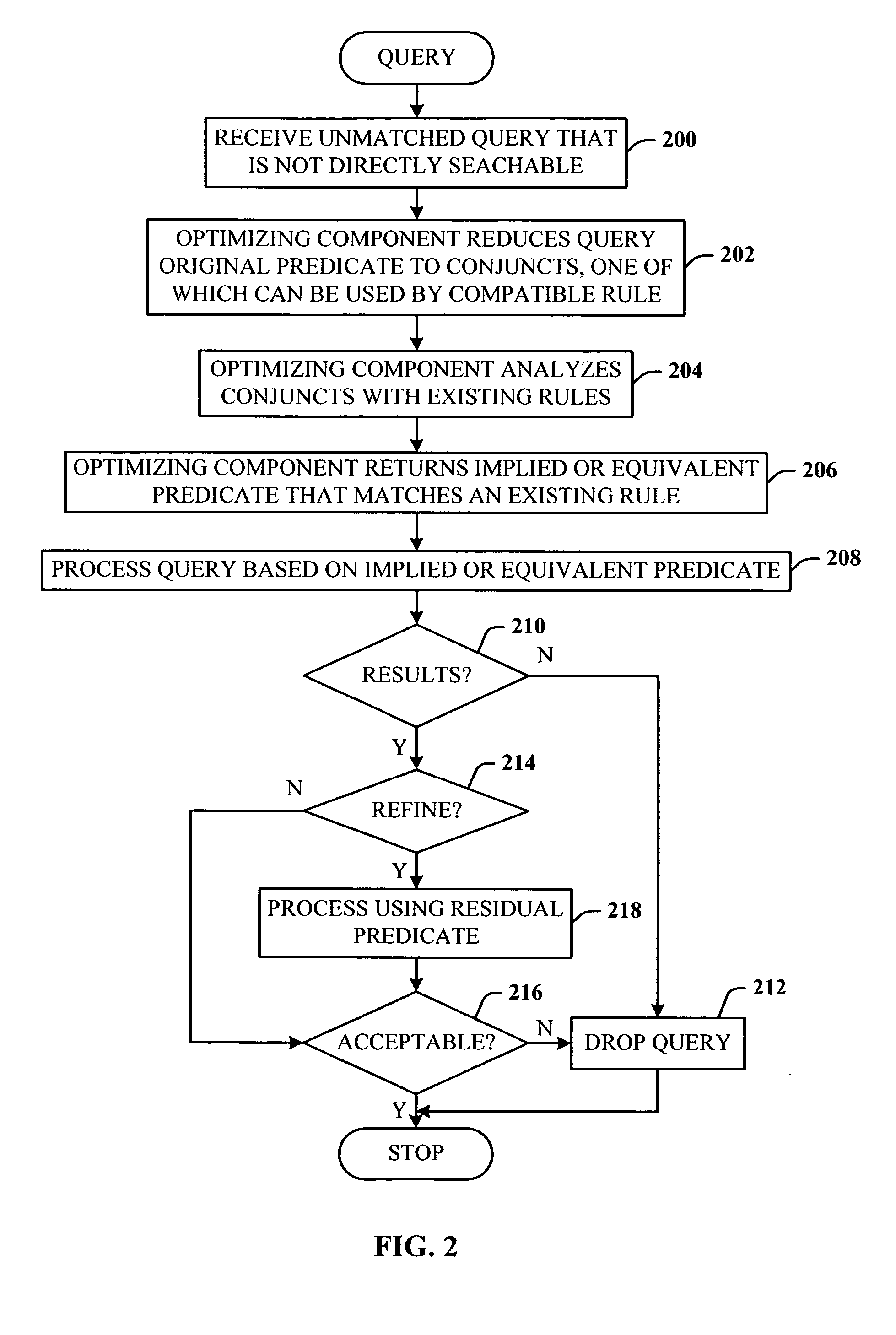Query optimizer using implied predicates
a query optimization and implied predicat technology, applied in the field of database systems, can solve the problems of database indexes having practical limits on the size of fields used, query optimization systems, and limited value comparisons, and achieve the effect of improving accuracy and cost-effectiveness
- Summary
- Abstract
- Description
- Claims
- Application Information
AI Technical Summary
Benefits of technology
Problems solved by technology
Method used
Image
Examples
example 1
[0074] For the spatial case in the spatial data type spec.
-- first create table-valued functionCREATE FUNCTION st_KeyGen(@g dbo.Geom, @minx int, @minyint, @maxx int, @maxy int, @max_tiles int, @max_depth int)RETURNS TABLE (key nvarchar (4000))EXTERNAL NAME spatialAssembly:spatialfunctions::st_KeyGen-- now create index extension scheme using this table-valuedfunctionCREATE INDEX EXTENSION SpatialIndexSchemeFOR (@p dbo.Geom)WITH PARAMETERS @minx int, @miny int, @maxx int @maxy int, @max_tiles int, @max_depth int)USING dbo.st_KeyGen(@p, @minx, @miny, @maxx, @maxy, @max_tiles, @max_depth)ON (key)
[0075] Dropping Index Extension Schemes
[0076] Syntax
DROP [[extension_schema.] extension_name
[0077] Rules
[0078] If there are any extended indexes in the database that are based on this index extension scheme, then it cannot be dropped.
[0079] Creating / Managing Extended Indexes
[0080] Once an index extension scheme is created, one or more indexes can be created using the index extension sc...
example 1 (
CONT'D.)
[0110]
CREATE RULE SpatialruleTYPE IMPLICATIONFOR dbo.st_Intersects(@p1 dbo.Geom, @p2 dbo.Geom)WITH INDEX TYPE SpatialIndexSchemeASEXISTS (SELECT * FROM st_keyGen(@p1,@minx,@miny,@maxx,@maxy,@max_tiles, @max_depth) i JOIN GetRanges(stBoundingBox(@p2,@max_tiles,@max_depth)) r ON i.key BETWEEN (r.keymin and r.keymax) UNION ALL SELECT * FROM st_keyGen(@p1,@minx,@miny,@maxx,@maxy, @max_tiles,@max_depth) i JOIN GetAncestors(stBoundingBox(@p2, @max_tiles,@max_depth) r ONi.key = r.key
[0111] User Query:
SELECT *FROM Suppliers sWHERE st_Intersects(s.Coverage, @inputArea) is rewritten asSELECT *FROM Suppliers sWHERE EXISTS ( SELECT * FROM (SELECT * FROM spatialIndex i WHERE i.ID=s.ID) t1 JOIN GetRanges (stBoundingBox(@p2,5,5)) r ON t1.key BETWEEN (r.keymin and r.keymax) UNION ALL SELECT * FROM (SELECT * FROM spatialIndex i WHERE i.ID=s.ID) t2 JOIN GetAncestors(stBoundingBox(@a_geometry, 5,5) r ON t2.key = r....
example 2
[0112] Consider a full-text indexing scheme that relies on indexing the results of a table-valued function ft_IndexGentextval) and returns a set of rows of the form (word, frequency, location) where there is an entry for each occurrence of each word in textval. Each row contains information about the word, its frequency, which is the number of occurrences in the document and location, which is an offset in textval where that occurrence of word is located. The table-valued function can be created as follows:
CREATE FUNCTION ft_IndexGen(@textval nvarchar(MAX))RETURNS TABLE (word nvarchar(300), frequency int, location int)EXTERNAL NAME FullTextLib:IndexGen::ft_IndexGen
[0113] The index extension will be created as follows:
CREATE INDEX EXTENSION FulltextIndexSchemeFOR (@p nvarchar(MAX))USING dbo.ft_IndexGen(@p)
[0114] Consider the predicate CONTAINS(@textval, ) which returns true only if all the words in appear at least once in @textval. The logic of the following rule is that CONTAIN...
PUM
 Login to View More
Login to View More Abstract
Description
Claims
Application Information
 Login to View More
Login to View More - R&D
- Intellectual Property
- Life Sciences
- Materials
- Tech Scout
- Unparalleled Data Quality
- Higher Quality Content
- 60% Fewer Hallucinations
Browse by: Latest US Patents, China's latest patents, Technical Efficacy Thesaurus, Application Domain, Technology Topic, Popular Technical Reports.
© 2025 PatSnap. All rights reserved.Legal|Privacy policy|Modern Slavery Act Transparency Statement|Sitemap|About US| Contact US: help@patsnap.com



